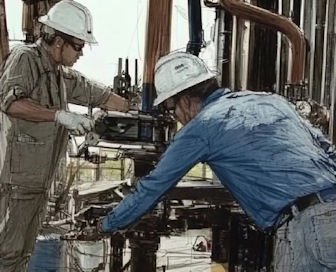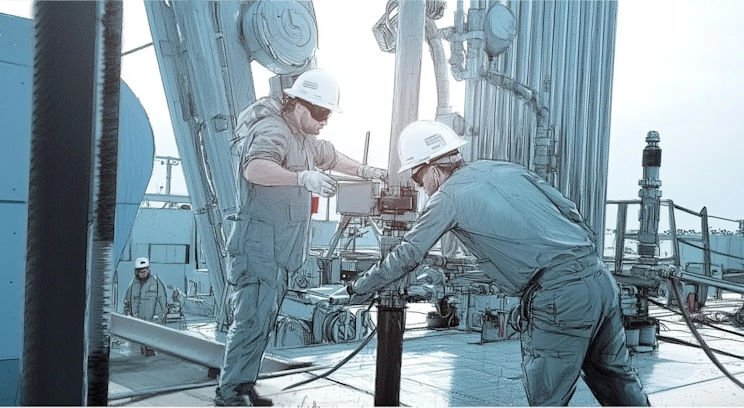Preparing for Tripping: Ensuring Safe and Efficient Operations
 Preparing for a trip is a critical step in maintaining the safety and efficiency of the drilling process. The driller must ensure both the hole and the drilling mud are ready before beginning the trip. Below are the key steps involved in the preparation
Preparing for a trip is a critical step in maintaining the safety and efficiency of the drilling process. The driller must ensure both the hole and the drilling mud are ready before beginning the trip. Below are the key steps involved in the preparation
1.Prepare the Hole and Drilling Mud:
- Clean the Hole: Ensure the hole is as clean as possible. For horizontal and high-angle wells, it may take up to four bottoms-ups to fully clean the hole.
- Condition the Mud: The mud should have low gel strengths but be sufficient to suspend barite. If gel strengths are too strong, they should be treated before the trip.
- Adjust Mud Density: Ensure the mud density provides an adequate trip margin without being excessive.
- Prepare the Trip Sheet: Fill out the trip sheet with all pre-recorded data to track the trip’s progress.
- Calculate Slug Volume/Density: Calculate the heavy slug volume and density needed for the desired length of dry pipe.
- Mix the Heavy Slug: Follow the plan to mix the heavy slug accordingly.
- Prepare Rig Floor Equipment: Ensure that all rig floor equipment is lined up and ready for the trip.
- Pre-Job Safety Meeting: Hold a safety meeting to discuss all aspects of the upcoming trip with the crew.
2. After Conditioning the Hole and Mud:
- Flow Check: Perform a flow check to confirm that the well is “dead” and there is no influx of fluid.
- Pre-Trip Safety Meeting: Meet with all crew members and service personnel involved in the trip to go over safety protocols.
- Pump the Heavy Slug: Pump the heavy slug into the well.
- Verify Mud Returns: Ensure the correct amount of mud is returned to the trip tank.
- Trip Out Slowly: Carefully trip out of the hole at a slow rate to avoid swabbing or surging, particularly in high-angle wells. This helps solids in the wellbore slide past the junk slots and the bit.
- Ream Through Tight Spots: If necessary, pump out or back ream through tight spots. Avoid pulling pipe faster than the mud’s annular velocity. If tight spots occur in high-angle intervals, back up by about five stands to clear the cuttings.
- Regularly Fill the Hole: Continue to monitor and fill the hole regularly to maintain fluid balance.
- Verify Fluid Returns: Use the trip sheet data to confirm that the hole is taking the correct amount of fluid.
- Swabbing or Circulation: If the well is not swabbing, continue the trip. If swabbing occurs, run or strip to the bottom and circulate out any kick fluid.
3. Prepare Rig Floor Equipment:
- Prepare for BHA Pull: Ensure the floor equipment is ready before pulling the Bottom Hole Assembly (BHA) through the stack.
- Location of Non-Sealable Tools: Confirm the location of any non-sealable tools in relation to the BHA to avoid obstruction.
- Fill the Hole: Before pulling the BHA through the stack, make sure the hole is filled with mud.
- Flow Check: Perform a flow check before pulling the BHA to ensure the well is secure.
- Shut the Blind Rams: Close the blind rams once the BHA is out of the hole.
- Monitor Flow: Keep an eye on the well for any flow through the trip tank during this process.
4. Running In Hole (RIH) and Monitoring:
- Safety Meeting Before Running In: Hold a safety meeting before starting the running-in operation with the new assembly.
- Run in Slowly: Move the new assembly into the hole at a controlled speed.
- Verify Returns: Ensure the returns to the trip tank are correct, adjusting tripping speed if needed.
- Circulate Bottoms Up: Once on bottom, circulate bottoms up and monitor for any trip gas readings.
- Be Ready to Circulate Trip Gas: Be prepared to circulate trip gas out through the choke if necessary.
 By carefully following these steps and maintaining a focus on safety and accuracy, the driller ensures that the trip is completed smoothly and without incident. Proper preparation, constant monitoring, and good communication with the team are essential for a successful operation.
For more information on tripping and other well control subjects, visit: https://learn-well-control.com/product/well-control-manual-by-edwin-ritchie/
By carefully following these steps and maintaining a focus on safety and accuracy, the driller ensures that the trip is completed smoothly and without incident. Proper preparation, constant monitoring, and good communication with the team are essential for a successful operation.
For more information on tripping and other well control subjects, visit: https://learn-well-control.com/product/well-control-manual-by-edwin-ritchie/ 